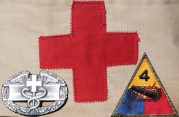These famous photos show medics of the 4th Armored Division treating a wounded man on a sidewalk. They were taken on July 30th, 1944 in a street in the city of Coutances, France.

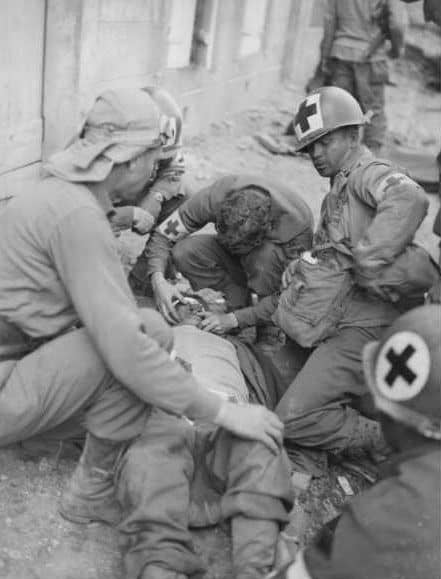
After doing some more research, I found that an incredible amount of photos (as well as color film) were taken in the same street over a period of two days in July 1944.
Many of them show medics of the 4th AD dealing with casualties who were injured within yards of each other.
Here I will analyze the photos and film taken in that street in Coutances, France, and recreate the story that they tell us. I would like to warn you that some of the images show the casualties and are shocking.
July 28th, 1944
At 3.00 am on the morning of July 28th, 1944 the 4th Armored Division received orders for its first offensive action in the ETO. Combat Command B (CCB) of the division was ordered to lead the attack, push through elements of the 90th Infantry Division, and attack toward Periers, St.Saveur-Lendelin, and finally Coutances.
CCB, under command of Brigadier General Holmes Dager, launched the attack at 5.00 am. With the incredible speed for which the division would become known, Coutances was reached around noon.
4th AD AAR 28th July


As the division After Action Report states, CCB was slowed by mines and it took until 18.00h before the city was under 4th AD control.
Map Coutances

This original US Army map (1/100,000) shows the route from the north, from the direction of Monthucon, that CCB took to reach Coutances.

It is the area in the black square, shown on this map, where the events described in this article took place: near the intersection where the roads with today’s numbers D971E3 and D972E3 meet. The road into town (D971E3) taken by CCB in 1944, is today called the Avenue Division Leclerc. After the intersection, it continues as the Boulevard d’Alsace Lorraine (D971E3). The road coming from the left of the intersection (D972E3) is called the Avenue de la République.
This image, taken from Google maps, show the area. The second images shows the roads and intersection.
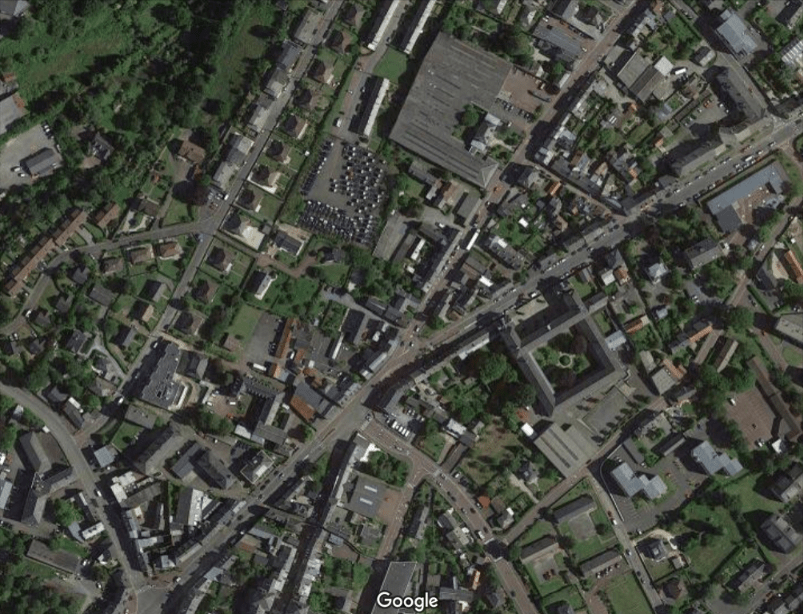

In the images taken in July 1944, we can find several buildings that help us find the location from where the photos were taken. I have given each of these buildings a distinct colored marking to help identify them. In this article I will publish the original photos and the same photos marked with the points of reference.
This google image shows the locations of these buildings.

As we have seen, elements of CCB were halted by mines. The first series of photos show evidence of this. They were taken on the Avenue Division Leclerc, facing south, toward the intersection. I will show them accompanied by the same image showing the marked buildings to help locate the photos:
CCB advancing


We can see units attached to CCB moving towards the city.
Wrecked 66AFAB Jeep
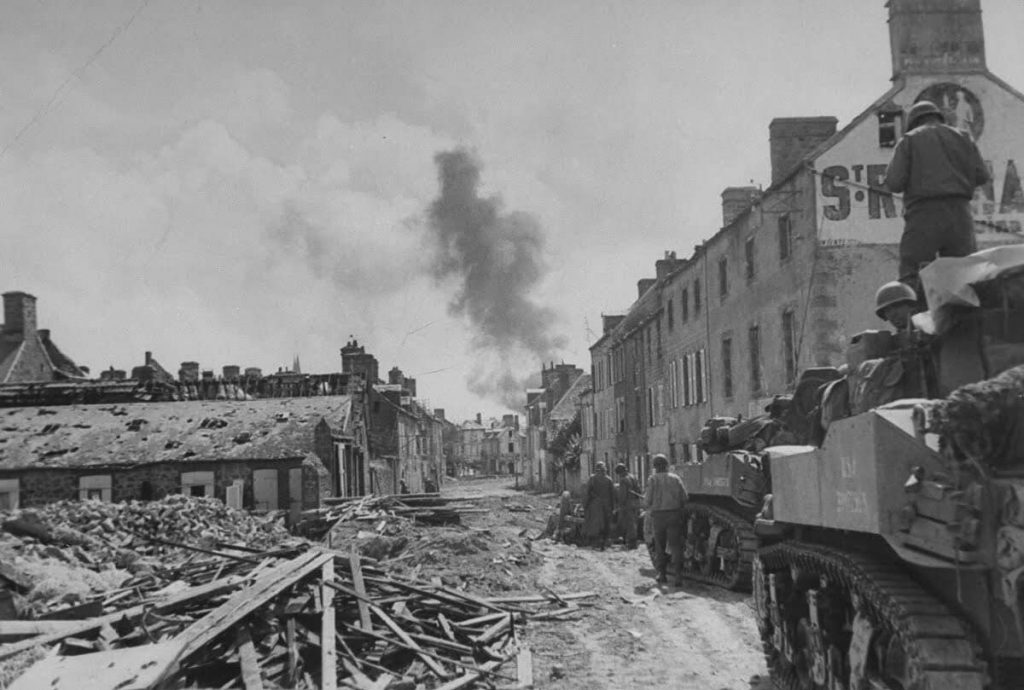



The first casualties are shown: a Jeep from the 66th Armored Field Artillery Battalion has struck a mine and landed upside down (marked with the yellow circle). The bodies of the men who drove in this Jeep are removed from the street by medics of the battalion. Note that the rest of the street, towards the intersection, is still empty.
Litter bearers


As these medics carry the bodies away, we can see that the convoy has started moving again in the background. We can see the wreckage of the Jeep on the side of the road.
Convoy hit by explosion


As the convoy moves further down the street, another mine is struck. This time by a Stuart tank. This photo shows the dust cloud from the explosion. We can also see the wreckage of the Jeep.
Wrecked Stuart tank


This photo was taken from the intersection, looking north. It shows the wreckage of the Stuart tank. Note the tank tracks that were blown off that lay on the road. Later images show these tracks moved to the side of the road, near the road sign marked by the green square. A sign was put up warning for mines.
Engineers with mine detector


This photo, taken further north on the same road, and looking north, shows a German POW being taken away. It also shows engineers with a mine detector case preparing to clear the road of remaining mines.
While the street was being cleared of mines, vehicles moving south were redirected through a small side road (Rue de la Croix Quillard) linking Avenue Division Leclerc and Avenue de la République.
Stuart Rue de la Croix Quillard


This photo shows a Stuart tank at the corner of the Avenue Division Leclerc and the Rue de la Croix Quillard. It also shows 4th AD medics evacuating more wounded men with their Jeep.
Rue Croix Quillard – Av. de la Republique

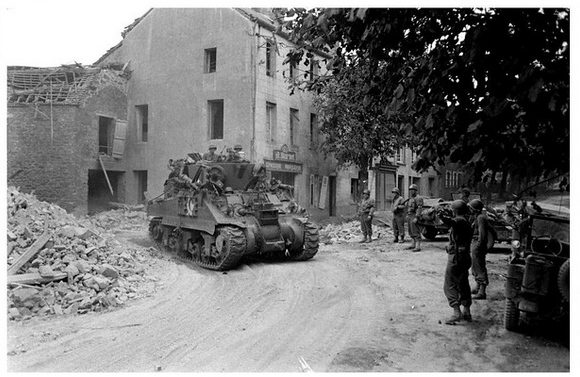
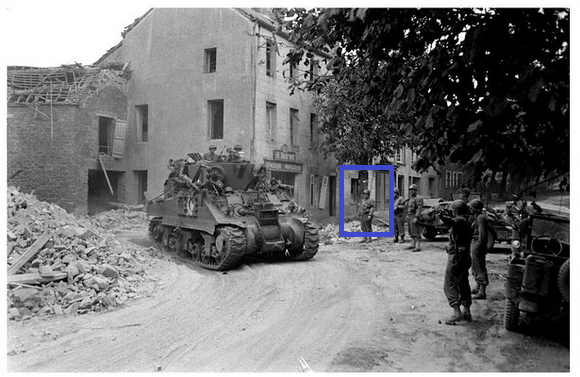


Here we can see vehicles turning right from the Rue de la Croix Quillard onto the Avenue de la République. The photo of the 4th AD medic talking to a German POW was taken on this corner. Note the explosives attached to the trunk of the tree. The Germans had placed these explosives to hinder the allied advance by blocking the roads with these trees.
The last photos of the 28th July 1944 show the convoy of the 4th AD driving down the Avenue de la République towards the Boulevard d’Alsace Lorraine, past the wreckage of the Stuart tank.
Convoy coming from Av. de la Republique

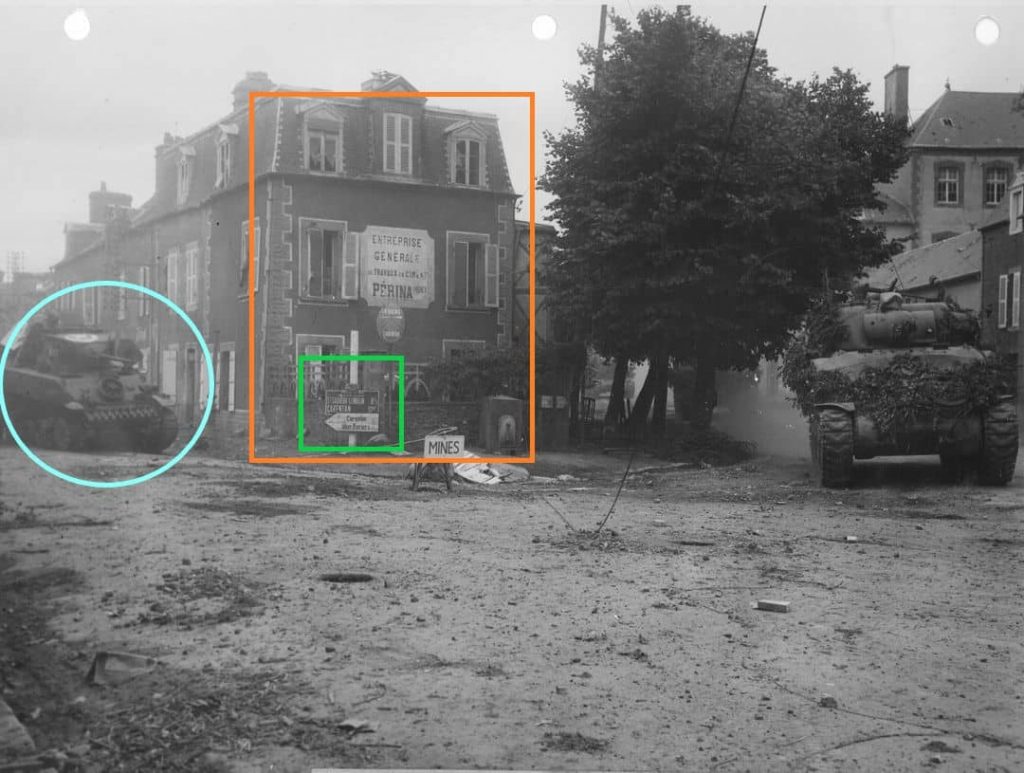

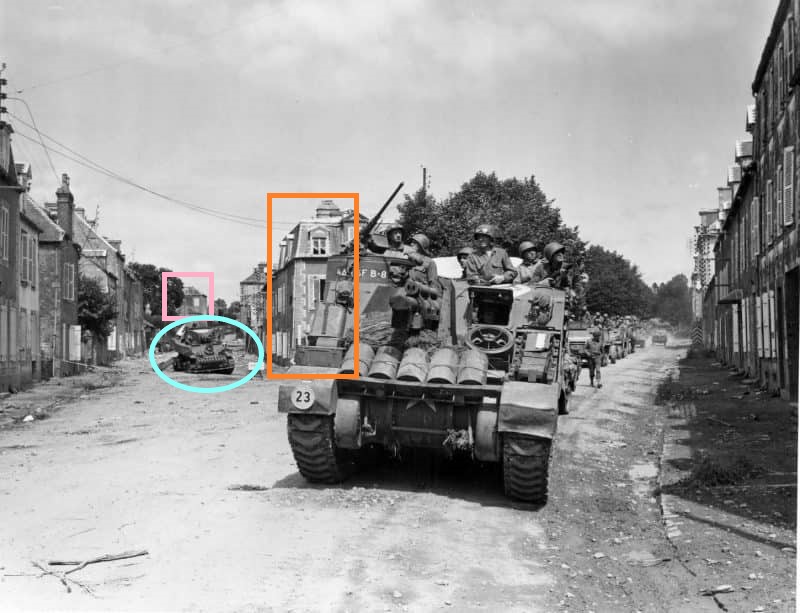
30th July 1944
Combat Command A (CCA) moved out on July 29th, 1944 with Company B, 46th AMB, and 10 ambulances of the 564th Ambulance Company in support for medical care.
Morning Report B/46
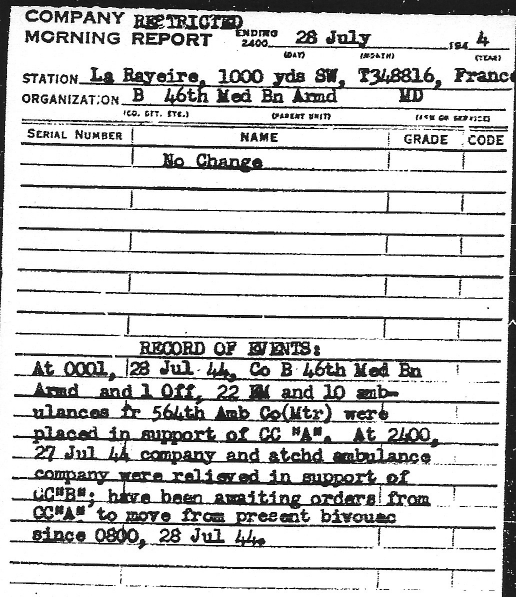
It moved through Coutances on July 30th. Reserve Command started its journey on the 30th of July and followed CCA through Coutances the same day. By this time the Avenue Division Leclerc (as it is now called) was again cleared for traffic. The wrecked Stuart tank was moved and all mines seemed to be removed from the road.
Filming these elements of the 4th AD as they drove through Coutances was a team of men of the US Army Signal Corps headed by director George Stevens. He had brought his camera with color film which he used to record the vehicles of the 4th AD this day.
The color footage filmed by George Stevens in Coutances is part of a collection that can be found on Youtube. The footage filmed in Coutances is part of this: https://youtu.be/LCipbUt-nK4.
As we can see, the footage is not shown in chronological order: film from the winter of 1944/1945 is presented before the section filmed in Coutances. I am therefore not convinced that the footage from Coutances is shown in the correct order. I have taken the footage from Coutances and edited the relevant sections for this article. Again, some of the images show casualties and are shocking:
Film Coutances July 30th, 1944
I have also found a film fragment that shows us the same scene from a different angle. This film is in black and white. It is a fragment taken from this video: https://www.youtube.com/watch?v=CSBSHU9ZLpY&t=1699s.
Now, let’s analyze the footage.
The film starts by looking at a road sign. After this shot, we see tanks of the 35th Tank Battalion parked on the side of the Boulevard d’Alsace Lorraine. The camera pans to the left, past a house with a red sign. This house is no longer there. It stood in front of the building marked with the red square. We can see the house with the red sign in the original photos. The camera pans further to the left, showing the Jeep with the trailer used by George Stevens and his crew. The Jeep is on the intersection, in front of the Rue Gambetta (a side road of the intersection)
Screenshot 1
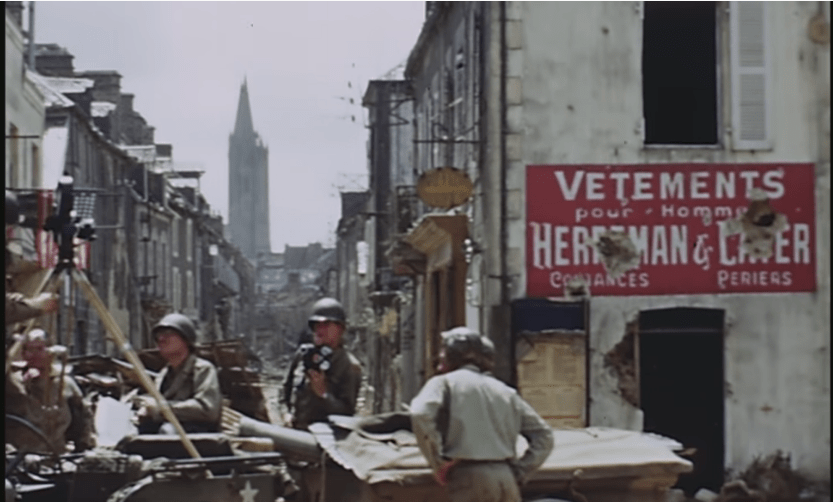
In the next scene, the cameraman was standing roughly in the same location as the first scene but is now facing across the intersection, looking towards what is now called the Avenue Division Leclerc. We can see the building at the corner, marked with the orange square. We can also see the road sign, marked with the green square.
Screenshot 2


Scene three shows us that the cameraman has moved across the intersection, close to the Avenue Division Leclerc. We see the building (orange marking) and the road sign (green marking) on the right. In the background, we can see the building with the pink marking.
Screenshot 3


What is significant is that we see a group of soldiers gathering in the street looking to the left, to the area behind the truck parked there.
Then there is the dramatic explosion on the left of the street, near the buildings to the side.

In the next scene, the cameraman has moved back a bit and we see the group of soldiers running away from the effects of the blast. Then the Jeep with the cameraman standing on it drives away. Perhaps you have noticed one soldier with a white “blob” attached to his helmet. This photo shows that it was a bouquet of flowers.
Soldier with flowers

The cameraman has moved back to the corner. We see the road sign (green), the building on the corner (orange), and now there is Harley Davison Liberator parked on the corner that was not there in the previous scene. It is probably the motorcycle of an MP.
Screenshot 5


This is also where we first see the wreckage of a Jeep that has landed on its top. It is located between a truck and two jeeps parked on the side of the street. There are more trucks parked behind the jeeps. (This is not the same Jeep that we saw in the photos of July 28th. That Jeep was destroyed some 50 to 75 yards to the north).
Screenshot 6


The cameraman moved a few yards for the next scene. We are now looking down the Avenue Division Leclerc. The parked vehicles and the wreckage of the Jeep are on the left of the street. We can see debris covering the street, presumably from the wrecked Jeep. Interestingly, the tracks from the wrecked Stuart tank, damaged on the 28th, are still there, on the right side of the street.
Screenshot 7


Now the camera moves closer to the wrecked Jeep.
The next part starts with a close-up of the road sign on the corner. Then the camera pans to the left, showing an ambulance of the Medical Detachment, 35th Tank Battalion, driving backward to make room for a Dodge WC-52 of the same medical detachment. In the background, another ambulance starts making its way toward the site of the wreckage.
Screenshot 8


Screenshot 9


Note that in the last screenshot, a soldier has climbed on the back of the truck parked on the side. Probably, this is the photographer who took one of the photos of the medics treating the wounded man on the pavement.
Photo casualty


Besides the medics treating the wounded man on the pavement, we can also see two soldiers who are about to place a blanket. It is likely the body of a soldier who was fatally injured by the mine explosion.
The next scene of the film is the most shocking. It shows a group of medics treating a severely wounded man. The man kneeling in the back, wearing a cap with goggles, turns out to be an MP shown by the brassard on his left arm. This could very well be the driver of the Harley Davidson we saw parked on the corner. We can also identify the other medics as they are shown in both photos make of this scene. The medic without a helmet is shown to wear a first lieutenant’s bar on his right collar. This means that he is either Maurice L. Greenberger, the Battalion Surgeon of the 35th Tank Battalion, or John P. O’Connor, the Assistant Battalion Surgeon.
Screenshot 10
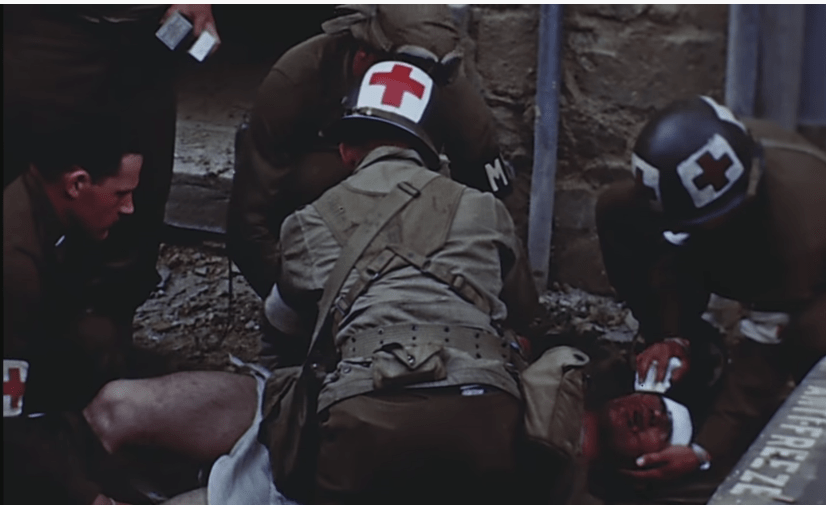

The wounded man is still alive as he is being treated.
Next, we look into the back of an ambulance. This ambulance is from the 564th Ambulance Company, attached to Company B, 46th Armored Medical Battalion. The wounded man is still moving his feet.
Screenshot 11

This is where the film stops showing the scene at the Avenue Division Leclerc.
It seems logical to assume that the shown explosion is the one responsible for the wrecked Jeep and the wounded men.
To be honest, I am not sure. As we have seen there was already a group of soldiers standing in the street looking to the left of the street, where we later see the wreckage of the Jeep. Perhaps the Jeep was destroyed by a mine in the street and then flipped towards the side of the street before the explosion shown in the film took place.
The explosion that is shown is off to the left side of the street, near the pavement. I don’t quite understand how this explosion could flip the Jeep over with all the other vehicles parked so close to the wreckage. So I suspect that the explosion in the film is a second one, that took place after the Jeep set off a mine in the road.
What we do know is that the men driving in the wrecked Jeep were Colonel Louis J. Storck, his driver, and his radioman. All three men unfortunately died of their wounds.
Colonel Storck was the commanding officer of the 4th Armored Division’s Reserve Command. His loss was a heavy blow to the division. Unfortunately, I have not yet identified his driver and radioman.
If you want to find out more about Colonel Storck, I recommend reading this post: https://www.facebook.com/PattonsVanguard/posts/10158185221295560
It was taken from the superb Facebook page created by Don M. Fox, who is also the author of the two-volume history of the 4th Armored Division. I highly recommend these books, they are fantastic!
Colonel Storck is buried at the Normandy American Cemetery and Memorial at Colleville-Sur-Mer in Plot E, Row 17, Grave 34.
Grave Colonel Storck

